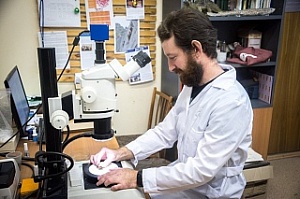A unique find was made several years ago in the Kemerovo Region. According to scientists, the egg belongs to predatory dinosaurs - troodontids, which are considered the ancestors of modern birds. The results of a study by paleontologists at TSU, St. Petersburg State University, the Museum of the Zoological Institute of the Russian Academy of Sciences (RAS), and the Paleontological Institute of the RAS, confirming this fact, were published in early November in the journal Historical Biology.
- The egg of a troodontid was discovered by our colleague Evgeny Mashchenko from the Paleontological Institute of the RAS (Moscow), with whom we worked on a grant from National Geographic, - says Stepan Ivantsov, a researcher at the Laboratory of Mesozoic and Cenozoic Continental Ecosystems of the Faculty of Geology and Geography. - We conducted excavations at the site of Shestakovo-3. The egg was in a layer of dense reddish clays, and it was extremely difficult to notice it because only the outline of the shells could be seen. This find is great luck because for Russia it is the first and so far the only one.
It is very interesting that 90% of the remains of ancient lizards that have been found at different times on Shestakovo-3 are psittacosaurus - primitive horned dinosaurs. The bones of their predatory brethren were found here extremely rarely, but the egg found during the joint expedition belongs precisely to predators. This is confirmed by the internal structure of the shell. The diameter of the egg is only two centimeters across. By the way, the adult troodontids were also very modest in size - up to one meter in height.
According to scientists, the approximate age of the find is about 100 million years. The embryo of the ancient animal was not preserved, as the egg-laying place of the dinosaur, which was in the floodplain of the ancient river, was destroyed by a flood. Nevertheless, the study of the shell conducted by the TSU paleontologists and their colleagues yielded interesting results.
The study of thin sections under an electron microscope showed a high similarity of their structure to the structure of the eggshell of modern birds. This fact is one more confirmation that all the birds that live on the Earth are descendants of carnivorous dinosaurs, who changed their appearance and lost their teeth in the process of evolution.
Paleontologists have not yet studied all the finds brought from the expedition to Shestakovo-3. Some of the rare exhibits are still in sandstone monoliths, from which scientists are gradually extracting the remains of dinosaurs and other animals that inhabited modern Siberia about 100 million years ago.

